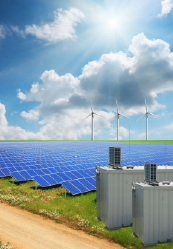Managing Nuclear Waste Effectively with the Nuclear Waste Management System Market
Nuclear waste is a type of hazardous waste made up of radioactive elements emitting radiation spontaneously. The radiation from nuclear waste affects several organs in our body, including the brain, teeth, skin, eyes, and heart. As such, proper collection, sorting, and disposal of this waste is highly important.
Nuclear waste management refers to the safe treatment and disposal of discharge from nuclear plants to protect people and the environment. The growing generation of nuclear waste worldwide and significant advancements in radioactive waste management solutions drive the nuclear waste management system market growth.
Types of Nuclear Waste
Depending on the radioactivity level, radioactive waste is classified into three main types. Here’s a quick overview of these:
Low-level waste: The radioactive content in this nuclear waste type doesn’t exceed four giga-becquerels per tonne (GBq/t). This waste type doesn’t need shielding while handling and transportation. Also, it can be disposed of in near-surface establishments.
Intermediate-level waste: This nuclear waste type is more radioactive than low-level waste and usually consists of resins and chemical sludges. Due to its high radioactivity level, intermediate-level waste needs some form of shielding.
High-level waste: High-level waste has the highest level of radioactivity. Also, the heat generated (>2 kW/m3) is high enough to increase the temperature of its surroundings. As such, high-level waste needs both shielding and cooling.
Market Analysis
According to new research by Polaris Market Research and Consulting, the nuclear waste management system market was valued at USD 20.39 billion in 2022 and is projected to grow to USD 28.43 billion by 2032.
Methods for Nuclear Waste Disposal
Below’s an overview of some standard methods for handling and irradiation of nuclear waste:
Incineration: Incineration is a nuclear waste management process that involves burning waste under controlled conditions. This disposal method is commonly used with low-level waste. This is because it usually consists of items that are just contaminated.
Storage: The radioactivity level of nuclear material tends to decay with time. As such, storing the material until its radioactivity goes away is another nuclear waste management method.
Deep burial: This is a common method for disposing of high-level waste. It involves burying the material deep beneath the earth. Sometimes, underground labs are built to monitor the storage and usage of the materials.
To Get More Insights on Nuclear Waste Management System Market, Request for a Sample Report
Low-Level Waste Segment is Anticipated to Grow at the Fastest Rate
Low-level waste management systems are important for safely handling, treating, and disposing of nuclear waste generated by research labs and nuclear power plants. Also, these systems are used to dispose of nuclear waste developed by hospitals and other industries. With the growing demand for nuclear energy and nuclear energy applications, the requirement for reliable and effective radioactive waste management solutions has also increased. As a result, the low-level waste management segment in the nuclear waste management system market is projected to grow at the fastest rate.
Asia Pacific is Projected to Witness the Highest Growth Rate
APAC has experienced a significant rise in the usage of nuclear energy for power generation. This is fueled by the increased demand for electricity and the need to lower greenhouse gas emissions. As the use of nuclear energy for energy generation continues to rise, the amount of corresponding nuclear waste generated will also increase. This, in turn, will drive the requirement for efficient radioactive management solutions and propel the market forward.
Final Saying
Nuclear waste management systems are crucial for safely treating and disposing of radioactive materials. Innovations in nuclear waste management systems, like the development of automation systems, have helped minimize radiation exposure and are impacting the nuclear waste management system market sales favorably.


